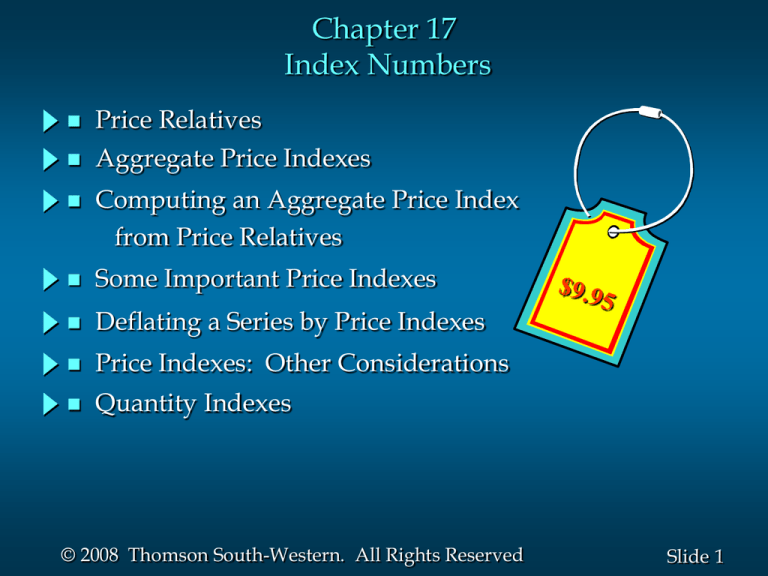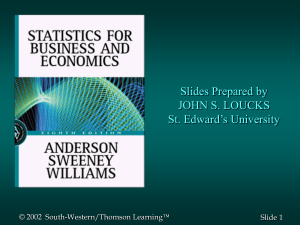
Chapter 17
Index Numbers
Price Relatives
Aggregate Price Indexes
Computing an Aggregate Price Index
from Price Relatives
Some Important Price Indexes
Deflating a Series by Price Indexes
Price Indexes: Other Considerations
Quantity Indexes
© 2008 Thomson South-Western. All Rights Reserved
Slide 1
Price Relatives
Price relatives are helpful in understanding and
interpreting changing economic and business
conditions over time.
$3.89
Now
Price of
Gasoline
Then
$0.99
© 2008 Thomson South-Western. All Rights Reserved
Slide 2
Price Relatives
A price relative shows how the current price per unit
for a given item compares to a base period price per
unit for the same item.
A price relative expresses the unit price in each
period as a percentage of the unit price in the base
period.
A base period is a given starting point in time.
Price in period t
Price relative in period t =
( 100)
Base period price
© 2008 Thomson South-Western. All Rights Reserved
Slide 3
Aggregate Price Indexes
An aggregate price index is developed for the specific
purpose of measuring the combined change of a
group of items.
An unweighted aggregate price index in period t,
denoted by It , is given by
Pit
It
( 100)
Pi 0
where
Pit = unit price for item i in period t
Pi 0 = unit price for item i in the base period
© 2008 Thomson South-Western. All Rights Reserved
Slide 4
Aggregate Price Indexes
With a weighted aggregate index each item in the
group is weighted according to its importance, which
typically is the quantity of usage.
Letting Qi = quantity for item i, the weighted aggregate
price index in period t is given by
Pit Q i
It
( 100)
Pi 0 Q i
where the sums are over all items in the group
© 2008 Thomson South-Western. All Rights Reserved
Slide 5
Aggregate Price Indexes
When the fixed quantity weights are determined
from the base-year usage, the index is called a
Laspeyres index.
When the weights are based on period t usage, the
index is a Paasche index.
© 2008 Thomson South-Western. All Rights Reserved
Slide 6
Some Important Price Indexes
Consumer Price Index (CPI)
• Primary measure of the cost of living in U.S.
•
Based on 400 items including food, housing,
clothing, transportation, and medical items.
•
Weighted aggregate price index with fixed weights
derived from a usage survey.
•
Published monthly by the U.S. Bureau of Labor
Statistics.
•
Its base period is 1982-1984 with an index of 100.
© 2008 Thomson South-Western. All Rights Reserved
Slide 7
Some Important Price Indexes
Producer Price Index (PPI)
• Measures the monthly changes in prices in primary
markets in the U.S.
• Used as a leading indicator of the future trend of
consumer prices and the cost of living.
• Covers raw, manufactured, and processed goods at
each level of processing.
•
•
Includes the output of manufacturing, agriculture,
forestry, fishing, mining, gas and electricity, and
public utilities.
Weighted average of price relatives using the
Laspeyres method.
© 2008 Thomson South-Western. All Rights Reserved
Slide 8
Some Important Price Indexes
Dow Jones Averages
• Indexes designed to show price trends and
movements on the New York Stock Exchange.
• The Dow Jones Industrial Average (DJIA) is based
on common stock prices of 30 industrial firms.
• The DJIA is not expressed as a percentage of baseyear prices.
• Another average is computed for 20 transportation
stocks, and another for 15 utility stocks.
© 2008 Thomson South-Western. All Rights Reserved
Slide 9
Deflating a Series by Price Indexes
In order to correctly interpret business activity over
time when it is expressed in dollar amounts, we
should adjust the data for the price-increase effect.
Removing the price-increase effect from a time series
is called deflating the series.
Deflating actual hourly wages results in real wages
or the purchasing power of wages.
© 2008 Thomson South-Western. All Rights Reserved
Slide 10
Price Indexes: Other Considerations
Selection of Items
• When the class of items is very large, a
representative group (usually not a random sample)
must be used.
•
The group of items in the aggregate index must be
periodically reviewed and revised if it is not
representative of the class of items in mind.
© 2008 Thomson South-Western. All Rights Reserved
Slide 11
Price Indexes: Other Considerations
Selection of a Base Period
• As a rule, the base period should not be too far
from the current period.
• For example, a CPI with a 1945 base period would
be difficult for most individuals to understand due
to unfamiliarity with conditions in 1945.
• The base period for most indexes is adjusted
periodically to a more recent period of time.
© 2008 Thomson South-Western. All Rights Reserved
Slide 12
Price Indexes: Other Considerations
Quality Changes
•
•
•
A basic assumption of price indexes is that the
prices are identified for the same items each
period.
Is a product that has undergone a major quality
change the same product it was?
A substantial quality improvement also may cause
an increase in the price of a product.
=
© 2008 Thomson South-Western. All Rights Reserved
?
Slide 13
Quantity Indexes
An index used to measure changes in quantity levels
over time is called a quantity index.
Probably the best known quantity index is the Index
of Industrial Production and Capacity Utilization.
A weighted aggregate quantity index is computed in
much the same way as a weighted aggregate price
index.
A weighted aggregate quantity index for period t is
given by
It
Q it w i
(100)
Qi0 w i
© 2008 Thomson South-Western. All Rights Reserved
Slide 14








